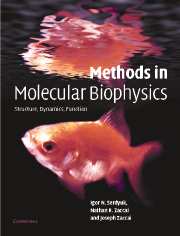Book contents
- Frontmatter
- Contents
- Foreword by D. M. Engelman
- Foreword by Pierre Joliot
- Preface
- Introduction: Molecular biophysics at the beginning of the twenty-first century: from ensemble measurements to single-molecule detection
- Part A Biological macromolecules and physical tools
- Part B Mass spectrometry
- Part C Thermodynamics
- Part D Hydrodynamics
- Chapter D1 Biological macromolecules as hydrodynamic particles
- Chapter D2 Fundamental theory
- Chapter D3 Macromolecular diffusion
- Chapter D4 Analytical ultracentrifugation
- Chapter D5 Electrophoresis
- Chapter D6 Electric birefringence
- Chapter D7 Flow birefringence
- Chapter D8 Fluorescence depolarisation
- Chapter D9 Viscosity
- Chapter D10 Dynamic light scattering
- Chapter D11 Fluorescence correlation spectroscopy
- Part E Optical spectroscopy
- Part F Optical microscopy
- Part G X-ray and neutron diffraction
- Part H Electron diffraction
- Part I Molecular dynamics
- Part J Nuclear magnetic resonance
- References
- Index of eminent scientists
- Subject Index
- References
Chapter D9 - Viscosity
from Part D - Hydrodynamics
Published online by Cambridge University Press: 05 November 2012
- Frontmatter
- Contents
- Foreword by D. M. Engelman
- Foreword by Pierre Joliot
- Preface
- Introduction: Molecular biophysics at the beginning of the twenty-first century: from ensemble measurements to single-molecule detection
- Part A Biological macromolecules and physical tools
- Part B Mass spectrometry
- Part C Thermodynamics
- Part D Hydrodynamics
- Chapter D1 Biological macromolecules as hydrodynamic particles
- Chapter D2 Fundamental theory
- Chapter D3 Macromolecular diffusion
- Chapter D4 Analytical ultracentrifugation
- Chapter D5 Electrophoresis
- Chapter D6 Electric birefringence
- Chapter D7 Flow birefringence
- Chapter D8 Fluorescence depolarisation
- Chapter D9 Viscosity
- Chapter D10 Dynamic light scattering
- Chapter D11 Fluorescence correlation spectroscopy
- Part E Optical spectroscopy
- Part F Optical microscopy
- Part G X-ray and neutron diffraction
- Part H Electron diffraction
- Part I Molecular dynamics
- Part J Nuclear magnetic resonance
- References
- Index of eminent scientists
- Subject Index
- References
Summary
Historical review
1846
J. L. Poiseuille produced a theory of liquid flow in a capillary. Based on this theory, W. Ostwald (1933) and L. Ubbelohde (1936) invented viscometers and introduced them into physical and chemical practice. Later, the instruments were named after them.
1906
A. Einstein was the first to treat the viscosity of suspensions of rigid spherical particles that are large relative to the size of the solvent molecules. He showed that the specific viscosity of the solution is proportional to the volume fraction of the solution occupied by the particles and does not depend on the absolute size of the spheres.
1932
H. Staudinger proposed using the intrinsic viscosity to determine the molecular mass of polymers. He found that the dependence of the intrinsic viscosity on the molecular mass for a homologous series of polymers can be expressed by a simple formula of the type [η] ≈ Mα. It became understood later (H. Mark, R. Houwink, W. Kuhn and H. Kuhn) that the constant α is related to the molecular conformation of the macromolecules in solution.
1962
B. H. Zimm and D. M. Crothers proposed an original design for a rotational viscometer that operates at low velocity gradients and which has been very useful for measurements on asymmetric structures such as DNA, fibrous proteins and rod-like viruses.
1985
M. A. Haney invented a ‘differential viscometer’ which measures the relative viscosity directly.
Information
- Type
- Chapter
- Information
- Methods in Molecular BiophysicsStructure, Dynamics, Function, pp. 466 - 480Publisher: Cambridge University PressPrint publication year: 2007
